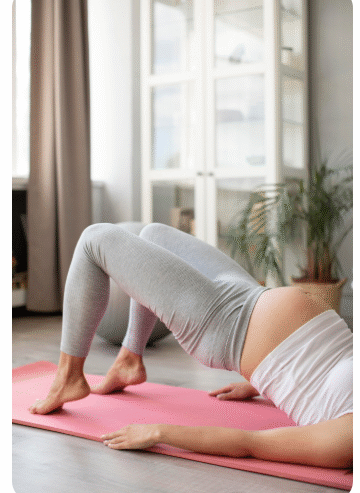
Hi there! From Chennai’s The Birthwave Clinic, I’m Dr. Santoshi Nandigam. We’re talking about pelvic floor exercise today — a crucial topic for women’s health. In this blog, you’ll learn how pelvic floor exercises support your body during adolescence, pregnancy, postpartum recovery, and menopause. You’ll also find clarity, strength-building techniques, and simple routines you can begin right now.
1. Describe the Pelvic Floor and Explain Its Significance
The pelvic floor is a layer of muscles, ligaments, and connective tissue that forms a supportive hammock at the base of the pelvis. It supports the bladder, uterus, vagina, and rectum.
Its key roles include:
Controlling the bowels and bladder
Supporting pregnancy and childbirth
Providing core and spinal stability
Enhancing sexual function and satisfaction
Up to 50% of women experience dysfunction after childbirth. At The Birthwave Clinic, we focus on restoring wellness through structured pelvic floor exercise programs.
2. Typical Pelvic Floor Issues
Common problems that may be improved with regular pelvic floor exercise include:
Pelvic Organ Prolapse: Weakened support causing organs to drop
Urinary Incontinence: Leakage during coughing, laughing, or exercise
Fecal Incontinence: Loss of bowel control
Pelvic Pain or Pressure: Often linked with poor muscle coordination
If you notice these symptoms, a pelvic floor evaluation may help.
3. Advantages of Pelvic Floor Exercise
Practicing pelvic floor exercise can bring transformative benefits:
Better bladder and bowel control
Reduced risk of prolapse
Enhanced posture and core stability
Relief from back or pelvic pain
Improved sexual responsiveness
According to Virginia Physicians for Women, pelvic floor exercises are vital during pregnancy, postpartum recovery, menopause, and active living.
4. Pelvic Floor Muscle Location and Activation
To engage in effective pelvic floor exercise, imagine stopping urine midstream or tightening your back passage.
Avoid these mistakes:
Holding your breath
Squeezing your glutes or thighs instead of the pelvic floor
Pushing downward rather than lifting upward
A helpful method is the “elevator technique,” where you contract gradually as if lifting each floor of an elevator, then relax fully.
5. Best Exercises for the Pelvic Floor
The following pelvic floor exercises are safe and effective for women at all life stages:
a. Elevator Technique and Kegels
Contract pelvic floor muscles for 3–5 seconds
Relax fully before repeating
10–15 reps, up to 3 times daily
b. Bridge Pose
Lie on your back with bent knees
Exhale, raise hips, and activate your pelvic floor
Hold 5–10 seconds, then release
Repeat 8–12 reps
c. Squats
Inhale as you squat down, exhale as you rise
Gently contract the pelvic floor as you come up
10–15 controlled reps
d. Bird Dog
From all fours, extend one arm and the opposite leg
Engage pelvic floor and hold for 3–5 seconds
Switch sides, 10 reps each
e. Cat-Cow with Engagement
Coordinate breathing with spine movement
Contract and relax the pelvic floor with each motion
f. Relaxation Techniques
Include diaphragmatic breathing or reverse Kegels
Prevent tension and ensure balanced coordination
6. Pelvic Floor Exercise Across Life Stages
Pre-pregnancy & Young Adults: Build strength early to prevent dysfunction.
Pregnancy: Gentle pelvic floor exercise helps prepare muscles for childbirth.
Postpartum (Fourth Trimester): Begin mild contractions after clearance from your doctor to prevent prolapse and aid recovery.
Menopause & Midlife: Hormonal changes weaken support; exercises combined with resistance training reduce risks.
Athletic & Active Women: High-impact sports put pressure on the pelvic floor; exercises prevent leakage and enhance performance.

7. Behaviors That Support Pelvic Health
Combine pelvic floor exercise with healthy habits:
Avoid straining during urination
Don’t take “just-in-case” bathroom breaks
Sit fully on the toilet instead of hovering
Stay hydrated and maintain a balanced lifestyle
8. Typical Exercise Mistakes
When performing pelvic floor exercises, avoid:
Breath holding
Using glutes or thighs instead of pelvic muscles
Over-straining without rest
Professional guidance ensures you practice safely and effectively.
9. Making Pelvic Floor Exercise a Part of Your Daily Routine
A balanced schedule may include:
Daily: Kegels (short + long holds)
3–4×/week: Bridge, squats, and bird dog
Daily or as needed: Cat-Cow and diaphragmatic breathing
Always: Healthy bladder habits
Consider using apps or biofeedback devices to track your pelvic floor exercise progress.
10. Research Support & Evidence
Studies show:
Cochrane reviews confirm that pelvic floor exercise reduces prolapse and incontinence symptoms.
Starting Kegels early in pregnancy can lower postpartum leakage risk by 30%.
Coordinating breathing with activation enhances pelvic stability.
11. When to Get Help from a Professional
Seek help if you experience:
Continuous leakage of urine or stool
Bulging or heaviness in the pelvis
Pain during intercourse
Constipation despite exercise
Worsening symptoms
At The Birthwave Clinic, we provide assessments, individualized physiotherapy programs, biofeedback training, and lifestyle counseling.
12. Sample Routine Chart
| Time/Stage | Exercises | Frequency |
|---|---|---|
| Daily | Kegels (short + long holds) | 10–15 reps, 3× daily |
| 3–4×/week | Bridge pose | 8–12 reps |
| 3–4×/week | Squats with pelvic contraction | 10–15 reps |
| 3–4×/week | Bird-Dog | 10 reps per side |
| Daily/As needed | Cat-Cow + diaphragmatic breathing | 5–10 min |
| Daily | Healthy bladder habits | Consistent practice |
Why Start Pelvic Floor Exercise at The Birthwave Clinic Right Now
At The Birthwave Clinic:
You get expert evaluations tailored to your needs
Safe, structured pelvic floor exercise programs for every stage of life
Focus on confidence, comfort, and lasting strength
We’re here to support you in your lifelong pelvic health journey.
Conclusion
Your pelvic floor is essential for health and confidence through young adulthood, pregnancy, postpartum recovery, and menopause. With the right guidance, mindful habits, and consistent pelvic floor exercise, you can prevent dysfunction, recover faster, and stay strong.
At The Birthwave Clinic, Dr. Santoshi Nandigam is dedicated to helping women maintain pelvic floor strength and stability at every stage.

